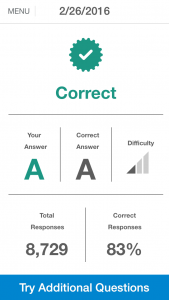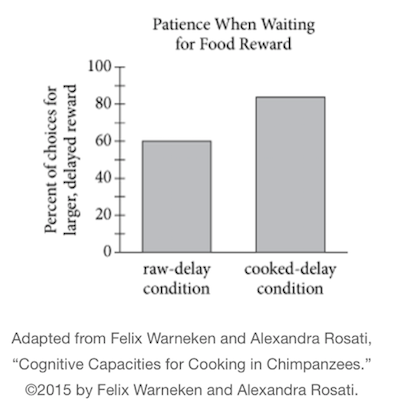The dates referred to in this post will be different if you have a newer version of the app. However, the app just cycles through the same questions, so everything in this post will still be relevant to you. You just won't be able to track down questions according to their date.
I've been taking a closer look at the writing questions of the day available on The College Board SAT app recently. It's quite helpful and serves as great practice. I highly recommend it.

As you can see, the app tells you the percentage of responses that were correct for each question. It also tells you the official difficulty level.
On the whole, the correct response rate was about 68%, which means on average, each question was answered correctly 69% of the time.
The following is a table of all the writing questions in the archive and their corresponding correct student response rates.
| Difficulty Level 1 | Difficulty Level 2 | Difficulty Level 3 | |||
|---|---|---|---|---|---|
| 12/11/2015 | 58% | 6/8/2016 | 32% | 5/7/2016* | 39% |
| 1/4/2016 | 58% | 10/8/2015 | 54% | 4/1/2016 | 49% |
| 1/28/2016 | 62% | 4/8/2016 | 55% | 4/12/2016 | 54% |
| 2/9/2016 | 64% | 2/5/2016 | 58% | 10/4/2015 | 55% |
| 9/26/2015 | 66% | 3/12/2016 | 61% | 12/27/2015 | 57% |
| 1/16/2016 | 67% | 3/24/2016 | 62% | 4/4/2016 | 57% |
| 11/25/2015 | 68% | 12/23/2015 | 64% | 4/29/2016 | 57% |
| 10/20/2015 | 70% | 5/23/2016 | 66% | 11/1/2015 | 58% |
| 12/19/2015 | 73% | 10/28/2015 | 67% | 5/11/2016 | 59% |
| 5/19/2016 | 73% | 11/5/2015 | 68% | 4/6/2017 | 60% |
| 2/25/2016 | 76% | 12/3/2015 | 69% | 4/25/2016 | 61% |
| 3/4/2016 | 76% | 5/31/2016 | 71% | 10/16/2015 | 62% |
| 5/27/2016 | 78% | 4/17/2016 | 72% | 11/17/2015 | 62% |
| 3/8/2016 | 79% | 5/3/2016 | 73% | 2/29/2016 | 63% |
| 2/1/2016 | 81% | 11/29/2015 | 74% | 9/30/2015 | 68% |
| 11/21/2015 | 84% | 12/15/2015 | 74% | 3/28/2016 | 68% |
| 3/20/2016 | 86% | 4/21/2016 | 74% | 12/7/2015 | 70% |
| 11/13/2015 | 89% | 10/24/2015 | 76% | 1/8/2016 | 70% |
| 5/15/2016 | 94% | 1/20/2016 | 76% | 1/24/2016 | 72% |
| 10/12/2015 | 80% | 1/12/2016 | 91% | ||
| 3/16/2016 | 82% | ||||
| 11/9/2015 | 87% | ||||
| 6/4/2016 | 87% | ||||
| 12/31/2015 | 95% | ||||
After going through all the writing questions in the archive, I noticed something peculiar. Some of the questions that were designated as hard (difficulty level 3) had correct response rates that were actually quite high.
For example, the January 12th, 2016 question (supposedly difficult) had a correct response rate of 91%, which is way higher than the average for all questions.
On the other hand, quite a few easy and medium questions had correct response rates in the 50%'s.
This discrepancy could be due to several factors:
- The top students only bother with the most difficult questions.
- What The College Board considers difficult is different from what most students would consider difficult.
- Because the exam was new when The College Board wrote some of these questions, they didn't have an accurate idea of their actual difficulty.
All factors are probably at play.
In any case, it's worthwhile to look at the questions with the lowest correct response rates. These are the questions that are actually difficult.
The 5 Toughest SAT Writing Questions of the Day according to Correct Student Response Rates
1. October 4th, 2015 (Only 55% of responses were correct)
While working together at the Jane Goodall Institute's Tchimpounga Chimpanzee Sanctuary in the Republic of Congo, cognition researchers Felix Warneken and Alexandra Rosati conducted an experiment comparing chimpanzees' decisions in two situations: a "raw-delay" condition and a "cooked-delay" condition. In the raw-delay condition, Warneken and Rosati offered the chimpanzees a choice between receiving a piece of raw food immediately and waiting for one minute to receive three pieces of raw food; the chimpanzees chose the larger, delayed reward 60 percent of the time. In the cooked-delay condition, in which the chimpanzees could receive one piece of raw food immediately or wait one minute for three pieces of cooked food, they chose the larger, delayed reward approximately 85 percent of the time.
Which choice most effectively introduces the main topic of the paragraph?
A) NO CHANGE
B) In a series of behavioral tests approved by Harvard University's Institutional Animal Care and Use Committee,
C) To determine whether chimpanzees are more likely to delay gratification for a cooked food reward than they are for a raw food reward,
D) As part of some fascinating work being conducted in the field of cognitive science,
2. October 8th, 2015 (Only 54% of responses were correct)
The creation of today's animated films, frequently hailed for their lifelike artistry, relies heavily on mathematics. Aspiring animators would benefit from a strong background in math if they wish to create, for instance, the rounded shapes making up an old man's knobby knuckles or a young girl's bouncy hair. One of the algorithms now considered an industry standard repeatedly subdivides a polygon by splitting and averaging the midpoint of a line. Developed by Pixar Animation Studio's Tony DeRose, this algorithm eliminates the problem of discernible edges of polygons by replacing them with the seamlessly rounded curves of the parabolas that emerge as a result of the polygon subdivision process. Innovations such as DeRose's depend on an understanding of applied mathematics in areas such as geometry, linear algebra, trigonometry, and calculus.
A) NO CHANGE
B) have relied
C) are relying
D) rely
3. April 12th, 2016 (Only 54% of responses were correct)
To determine whether chimpanzees are more likely to delay gratification for a cooked food reward than they are for a raw food reward, cognition researchers Felix Warneken and Alexandra Rosati conducted an experiment comparing chimpanzees' decisions in two situations: a "raw-delay" condition and a "cooked-delay" condition. In the raw-delay condition, Warneken and Rosati offered the chimpanzees a choice between receiving a piece of raw food immediately and waiting for one minute to receive three pieces of raw food; the researchers tested 60 chimpanzees in the raw-delay condition. In the cooked-delay condition, in which the chimpanzees could receive one piece of raw food immediately or wait one minute for three pieces of cooked food, they chose the larger, delayed reward approximately 85 percent of the time.

The writer wants to accurately incorporate information from the graph, which presents data collected during the experiment described in the paragraph. Which choice best accomplishes this goal?
A) NO CHANGE
B) the chimpanzees chose the larger, delayed reward 60 percent of the time.
C) the choices for the larger, delayed reward increased by approximately 85 percent.
D) chimpanzees selected the larger, delayed reward approximately 85 percent of the time in the raw-delay condition.
4. April 1st, 2016 (Only 49% of responses were correct)
Ghosts, haunted houses, ancestral curses—these common tropes of Gothic literature might lead some readers to dismiss the genre as one better suited for entertainment than for serious literary scholarship. An analysis of Charlotte Perkins Gilman's 1892 short story "The Yellow Wallpaper," though, demonstrates that the Gothic was a vehicle for serious social commentary worthy of further study. The story's protagonist, suffering from a "nervous condition," becomes obsessed with the wallpaper in her bedroom. At one point, she conjures a disturbing image of a woman trapped behind the bars depicted in the pattern of the wallpaper. Though utterly fantastical, this image is very much grounded in the reality of the oppressive mores of the Victorian era: the trapped figure symbolizes the protagonist's sense of being imprisoned by her social circumstances.
A) NO CHANGE
B) era. The trapped figure symbolizes:
C) era; the trapped figure symbolizes,
D) era the trapped figure symbolizes
5. June 8th, 2016 (Only 32% of responses were correct)
The song opens with three drummers tapping their panderos. The largest of the panderos—a hand drum called the seguidor—provides the pulse of the music. Two smaller hand drums—the segundo and the requinto—weave in and out of that beat. Each pandero adds a layer to the complex, syncopated rhythm the drummers tap out on their panderos. A maraca and an accordian chime in and are soon joined by the ratchet-like scrape of the güiro. Next, the singers pipe up, one calling and two others responding in a playful chant. As the music builds to a crescendo, I detect a twist on the traditional Puerto Rican folk style: a trombone bursts in and then a clarinet. They add an element of big band jazz. Underneath the fused musical styles, though, the classic plena rhythm, propelled by the panderos, beats on.
Which choice adds a new supporting detail most relevant to the main focus of the paragraph?
A) NO CHANGE
B) I have fond memories of dancing along to.
C) that characterizes this particular genre of music.
D) I immediately recognize as that of plena music.
Post your answers in the comments. For more challenging questions, I highly recommend my SAT Writing book. Check it out.
